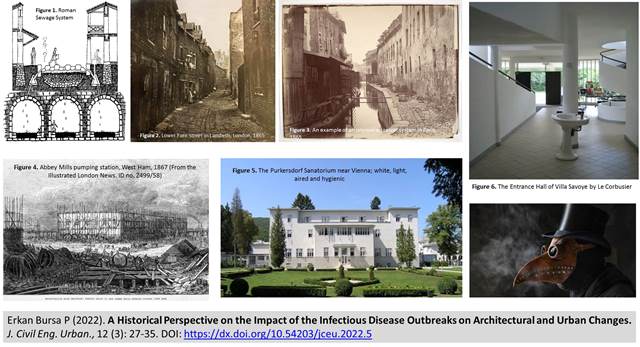Most read content
Partner Journal
Previous issue | Next issue | Archive
Volume 12 (3); September 25, 2022
|
|
Research Paper
A Historical Perspective on the Impact of the Infectious Disease Outbreaks on Architectural and Urban Changes
Erkan Bursa P.
J. Civil Eng. Urban., 12(3): 27-35, 2022; pii:S225204302100005-12
DOI: https://dx.doi.org/10.54203/jceu.2022.5
Abstract
There has been illnesses and pandemics all through the history effecting the cities. Some of the most significant architectural and urban changes occured in the cities due to infectious illnesses. The recent emergence of the coronavirus disease (SARS-CoV-2) which was declared as a pandemic in March 2020 with its continuing effects on human life despite all technological and medical advances in the last century and together with the phenomena such as population growth, rapid urbanization, increase in urban and architectural life comfort, has led to an immediate expectation to produce solutions with rapid changes in urban and architectural areas. This paper investigates what happened in the history of cities to develope healthy and hygenic living environments in search of an evaluation whether it is possible to provide humanity architecturally with living spaces in cities free of illnesses or if it is an illusion in terms of reality.
Keywords: Healthy Cities, Healthy Design, History of Architecture, History of Cities, Pandemics.
[Full text-PDF] [Crossref Metadata] [Export from ePrints]
|
|
Research Paper
Progressive Collapse Evaluation of Low-Rise Reinforced Concrete Buildings Designed for Different Occupancy Classes
Demir A.
J. Civil Eng. Urban., 12(3): 36-43, 2022; pii:S225204302100006-12
DOI: https://dx.doi.org/10.54203/jceu.2022.6
Abstract
The study aims to investigate the progressive collapse behavior of low-rise reinforced concrete buildings designed for different occupancy classes. For this objective, two low-rise reinforced concrete framed buildings were designed independently according to the Turkish Seismic Code for Buildings by considering the Residential Occupancy Class and Government Buildings Occupancy Class. A nonlinear dynamic analysis method was employed to evaluate the progressive collapse response of the buildings by using the alternate path direct design approach of UFC 4-023-03 and GSA-2016 guidelines. Three-dimensional finite element models were created for the analyses, and fiber hinges were used to represent the nonlinear behavior of the load-bearing members. Three column loss scenarios were implemented independently. The analysis results show that the residual displacement of the residential building is higher than that of the government building in all column removal scenarios. Moreover, the damage conditions of the residential building are commonly worse than the government building for all column loss scenarios. It is deduced from the study that the buildings experienced the most severe local damage, disproportionate to the initial failure, under the inner column loss scenario.
Keywords: Progressive Collapse, Occupancy Class, Nonlinear Dynamic Analysis, Reinforced Concrete, Turkish Seismic Code for Buildings.
[Full text-PDF] [Crossref Metadata] [Export from ePrints]
|
|
Research Paper
Intercomparison of Estimates of Reference Evapotranspiration of Surat Region of Gujarat, India
Vivekanandan N, Srishailam C and Patil RG.
J. Civil Eng. Urban., 12(3): 44-50, 2022; pii:S225204302100007-12
DOI: https://dx.doi.org/10.54203/jceu.2022.7
Abstract
Evapotranspiration is a vital parameter for irrigation planning and management, and for hydrological and climatological studies. This can be estimated by using Blaney-Criddle (BC), Thornthwaite (TW), Hargreaves (HG) and Penman-Monteith (PM) methods. Out of these methods, BC and TW are known as temperature based whereas HG is radiation based and PM is based on Food and Agriculture Organization (FAO) report on crop water requirements. This paper illustrates a study on comparison on estimates of reference evapotranspiration (ETo) obtained from temperature, radiation and FAO based methods for Surat region. The meteorological data such as air temperature, relative humidity and sunshine hours observed at Surat region for the period 2001 to 2016 is used. In addition, the wind speed and solar radiation data is downloaded from the International Water Management Institute website and used in estimation of ETo using PM. The performance of the methods used in estimation of ETo is evaluated through regression analysis by developing a linear regression between the observed and estimated values of ETo using BC, TW and HG, and FAO based PM. The results of linear regression analysis indicated that there is a good line of agreement between the observed and estimated ETo using PM with CC of 0.968 when compared with those values of BC, TW and HG. The study show that the PM is better suited amongst four methods applied in estimating the ETo for Surat region, Gujarat.
Keywords: Blaney-Criddle, Correlation Coefficient, Evapotranspiration, Hargreaves, Linear Regression, Penman-Monteith, Thornthwaite
[Full text-PDF] [Crossref Metadata] [Export from ePrints]
Previous issue | Next issue | Archive
This work is licensed under a Creative Commons Attribution 4.0 International License (CC BY 4.0)![]()






